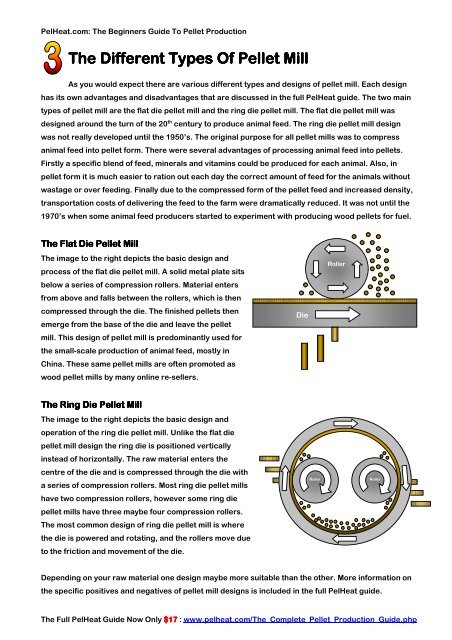The Beginners Guide To Pellet Production
The Beginners Guide To Pellet Production
The Beginners Guide To Pellet Production
Create successful ePaper yourself
Turn your PDF publications into a flip-book with our unique Google optimized e-Paper software.
PelHeat.com: <strong>The</strong> <strong>Beginners</strong> <strong>Guide</strong> <strong>To</strong> <strong>Pellet</strong> <strong>Production</strong><strong>The</strong> Different ent Types Of <strong>Pellet</strong> MillAs you would expect there are various different types and designs of pellet mill. Each designhas its own advantages and disadvantages that are discussed in the full PelHeat guide. <strong>The</strong> two maintypes of pellet mill are the flat die pellet mill and the ring die pellet mill. <strong>The</strong> flat die pellet mill wasdesigned around the turn of the 20 th century to produce animal feed. <strong>The</strong> ring die pellet mill designwas not really developed until the 1950’s. <strong>The</strong> original purpose for all pellet mills was to compressanimal feed into pellet form. <strong>The</strong>re were several advantages of processing animal feed into pellets.Firstly a specific blend of feed, minerals and vitamins could be produced for each animal. Also, inpellet form it is much easier to ration out each day the correct amount of feed for the animals withoutwastage or over feeding. Finally due to the compressed form of the pellet feed and increased density,transportation costs of delivering the feed to the farm were dramatically reduced. It was not until the1970’s when some animal feed producers started to experiment with producing wood pellets for fuel.<strong>The</strong> Flat Die <strong>Pellet</strong> Mill<strong>The</strong> image to the right depicts the basic design andprocess of the flat die pellet mill. A solid metal plate sitsbelow a series of compression rollers. Material entersfrom above and falls between the rollers, which is thencompressed through the die. <strong>The</strong> finished pellets thenemerge from the base of the die and leave the pelletmill. This design of pellet mill is predominantly used forthe small-scale production of animal feed, mostly inChina. <strong>The</strong>se same pellet mills are often promoted aswood pellet mills by many online re-sellers.DieRoller<strong>The</strong> Ring Die <strong>Pellet</strong> Mill<strong>The</strong> image to the right depicts the basic design andoperation of the ring die pellet mill. Unlike the flat diepellet mill design the ring die is positioned verticallyinstead of horizontally. <strong>The</strong> raw material enters thecentre of the die and is compressed through the die witha series of compression rollers. Most ring die pellet millshave two compression rollers, however some ring diepellet mills have three maybe four compression rollers.<strong>The</strong> most common design of ring die pellet mill is wherethe die is powered and rotating, and the rollers move dueto the friction and movement of the die.RollerRollerDepending on your raw material one design maybe more suitable than the other. More information onthe specific positives and negatives of pellet mill designs is included in the full PelHeat guide.<strong>The</strong> Full PelHeat <strong>Guide</strong> Now Only $17 : www.pelheat.com/<strong>The</strong>_Complete_<strong>Pellet</strong>_<strong>Production</strong>_<strong>Guide</strong>.php
















